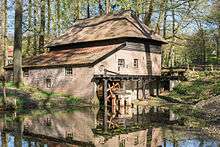Netherlands Open Air Museum
The Netherlands Open Air Museum (Dutch: Nederlands Openluchtmuseum) is an open-air museum located in Arnhem with antique houses, farms and factories from different parts of the Netherlands. It is a national museum focusing on the culture associated with the everyday lives of ordinary people. This will be linked to key aspects of Dutch history, including the Dutch East India Company and Michiel de Ruyter, as well as the First World War, slavery and child labour. The park was established on 24 April 1912 and open to the public from July 1918, over the last century the Netherlands Open Air Museum has grown to become one of the country's most visited museums. Annually, the museum has more than 555,000 visitors.
Nederlands Openluchtmuseum | |
Houses from the Zaan region | |
 Location in Gelderland in the Netherlands | |
| Established | 1912 |
|---|---|
| Location | Schelmseweg 89 Arnhem, Netherlands |
| Coordinates | 52°0′38″N 5°54′37″E |
| Type | Open-air museum |
| Visitors | 509,000 (2013)[1]
|
| Director | Pieter-Matthijs Gijsbers |
| President | Jeroen van der Veer |
| Website | openluchtmuseum |
The Museum
The park is about 44 hectares in area and includes buildings from various places and historical periods. There are around forty historic buildings that you can enter and see from the inside and there is also a historic tram that can transport you through the park. Inside the historic houses and farms there might be employees or volunteers available that can tell you more about the house and its history. The museum also has a collection of historical clothing and jewellery. New indoor exhibition space was built in 1999–2000. The museum won the European Museum of the Year Award in 2005.[2]
On site at the museum, there are re-enactors demonstrating the old way of life. Among these demonstrations are paper production, linseed production, and beer brewing.
The heritage tram line opened in the museum in 1996. The line is 1750 m long, standard gauge. It has classic electric trams from Amsterdam, Arnhem, Rotterdam, and The Hague. The pride of the museum's line is a replica of an Arnhem tram from 1929, the GETA 76, which was constructed by the museum.[3]
History
Establishment
The Open Air Museum was created after Frederic Adolph Hoefer, suggested a plan in April of 1912 to build an Open Air Museum. He came up with this idea after visiting similar parks museums in Scandinavia. The rise of industrialization and urbanization caused regional differences to disappear. Traditions and craftsmanship threatened to vanish. By moving historical building to the museum, with people knowledgeable about the history, visitors could be shown how people used to live. This way the old traditions could be preserved the "Vereniging voor Volkskunde Het Nederlands Openluchtmuseum" (Association for Folklore The Dutch Open Air Museum) was created that same month. It opened its door on 13 of July 1918. At the time of its opening the museum contained 6 buildings that had been moved in from other locations across the country. One of the first buildings was the los hoes originally build in Beuningen in the 17th century.
World War II
During World War II the museum was hit with incendiary bombs, this caused a building in the Zaanse buurt to go up in flames. In 1941 the museum was renamed to the Rijksmuseum voor Volkskunde (National museum for folklore). During the Battle of Arnhem the museum was temporally lived in by some hundred evacuees. On the 17th of November 1944 Franneke van der Kallen was born in one of the houses in the Zaanse buurt. Later on the 15th of November 1944 Nora Olga Marijke was born. Her initials stand for NOM (Nederlands Openluchtmuseum). A third child passed away two weeks after birth. In 1945 during an attack from a V-1 flying bomb the collection of garbs and painted furniture were lost.
Research
Some research is done on-site at the Open Air Museum for the dating and conservation of materials acquired. The Multimedia Library of the museum contains pictures, slides, diagrams, videos, and audio recordings documenting Dutch folk life. They also work in tandem with the Foundation for Historical Farm Research (SHBO), the Working Party for Farmyards Foundation (SWB), and the Centre for Documentation and Information on Regional Dress (SDI) in their research on folk culture.[4]
Gallery
 Paper mill
Paper mill Tramway
Tramway German border crossing from WWI, part of the Wire of Death
German border crossing from WWI, part of the Wire of Death- Farmhouse
.jpg) Two Amsterdam houses in the Arnhem Open Air Museum
Two Amsterdam houses in the Arnhem Open Air Museum- Houses from the Zaan region
References
- (in Dutch) 509.000 Bezoekers voor Openluchtmuseum Archived 2015-05-02 at the Wayback Machine (press release), Netherlands Open Air Museum, 2013. Retrieved on 28 June 2014.
- "Museum Pipped". The Journal. 2005-05-10. Retrieved 2008-03-21.
- "Tram". Nederlands Openluchtmuseum. Archived from the original on 2007-09-17. Retrieved 2008-03-21.
- Ton Wagemakers (2000). Nederlands Openluchtmusuem. Openluchtmuseum.
- Wagemakers, Ton. Nederlands Openluchtmuseum, Arnem. Trans. WTS, World Translation Services, Zeist. Nederlands Openluchtmuseum, 2000.
- History. Nederlands Openluchtmuseum. Retrieved on 2008-04-27.
- Mission. Nederlands Openluchtmuseum. Retrieved on 2008-04-27.
External links
| Wikimedia Commons has media related to Nederlands Openluchtmuseum. |
- Museum website (in Dutch)
- Museum website (in English)
- Mecanoo Architecten information